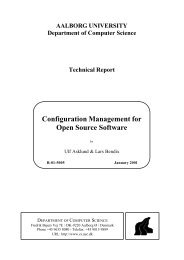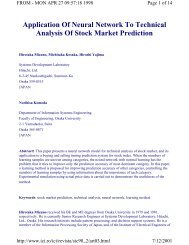ITEM TOOLKIT
ITEM Toolkit Manual
ITEM Toolkit Manual
You also want an ePaper? Increase the reach of your titles
YUMPU automatically turns print PDFs into web optimized ePapers that Google loves.
108 <strong>ITEM</strong> ToolKit Getting Started Guide<br />
Mean Time To Failure (MTTF)<br />
MTTF is a basic measure of reliability for non-repairable systems. It is the mean time expected to the first failure of a piece<br />
of equipment. MTTF is a statistical value and is meant to be the mean over a long period of time and large number of units.<br />
For constant failure rate systems, MTTF is the inverse of the failure rate.<br />
If failure rate is in failures/million hours, MTTF = 1,000,000 / Failure Rate for components with exponential distributions.<br />
Mean Time To Repair (MTTR)<br />
Mean Time to Repair is defined as the total amount of time spent performing all corrective maintenance repairs divided by<br />
the total number of those repairs.<br />
2. Using ToolKit for Reliability Predictions<br />
ToolKit allows you to build reliability predictions based on Bellcore, Mil-217, NSWC, RDF 2000 and 299B standards.<br />
ToolKit automatically calculates the failure rates and MTBFs associated with components as they are added to the system.<br />
In addition, it automatically updates all dependent failure rates in the system as well as the overall project failure rate.<br />
Mil-217<br />
The most widely known and used reliability prediction handbook is Mil-217. It contains failure rate models for electronic<br />
system parts such as ICs, transistors, diodes, resistors, capacitors, relays, switches, and connectors.<br />
Telcordia (Bellcore)<br />
A product of Bell Communications Research, the Telcordia handbook is derived from the Mil-217 handbook. The Telcordia<br />
reliability prediction procedure is applicable to commercial electronic products. Many commercial electronic product<br />
companies are now using the Telcordia handbook for their reliability predictions.<br />
NSWC<br />
The NSWC Standard is a commonly used model for mechanical components. NSWC uses a series of models for various<br />
categories of mechanical components to predict failure rates based on temperatures, stresses, flow rates and various other<br />
parameters. It provides models for various types of mechanical devices including springs, bearings, seals, motors, brakes,<br />
and clutches. NSWC is a relatively new standard, and is currently the only one of its kind.<br />
IEC 62380 (RDF 2000)<br />
The IEC 62380 Module supports methods of reliability prediction as described in the French standard published by the<br />
Union Technique de L’Electricite (UTE, July 2000). IEC 62380 is a universal model for reliability prediction of<br />
electronics, printed circuit boards and equipment, which takes directly into account the influence of the environment.<br />
Environmental factors are no longer used as they are replaced by mission profile undergone by the equipment. The module<br />
can handle permanent working, on/off cycling and dormant applications.<br />
CHINA 299B<br />
The 299B module supports methods of reliability prediction as described in Chinese 299B standard. 299B is a reliability<br />
prediction guide for electronic parts in both commercial and military industries. The standard provides the user with the<br />
opportunity to take into account the environmental conditions, quality levels, and stress conditions. The module provides<br />
procedures to perform Parts Stress Analysis as well as Parts Count Analysis.




